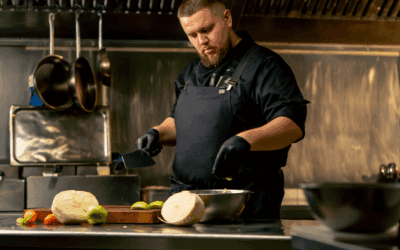Vencer projetos de consultoria é semelhante a obter sucesso nos esportes; ambos exigem uma estratégia clara, uma equipe coesa e uma liderança eficaz. Não importa se você está liderando uma iniciativa de consultoria de alto risco ou levando sua equipe esportiva favorita à vitória, os princípios subjacentes são muito semelhantes.
O sucesso em consultoria, assim como nos esportes, depende da combinação certa de talento, preparação e execução. Formando uma equipe dos sonhos A formação de uma equipe para projetos de consultoria envolve não apenas a reunião de profissionais qualificados, mas também a garantia de que eles trabalhem juntos de forma integrada para atingir um objetivo comum. Vamos explorar as sete etapas que podem orientá-lo na montagem e na liderança de uma equipe que levará seus projetos de consultoria ao sucesso.
O que o basquete e os projetos de consultoria têm em comum? Mais do que você imagina! Ambos exigem estratégia, trabalho em equipe e liderança eficaz para alcançar o sucesso. Assim como um técnico de basquete elabora um plano de jogo e seleciona os jogadores certos, um gerente de projeto orquestra a trajetória de um projeto e reúne uma equipe de especialistas. Vamos dar um mergulho lúdico em como os princípios do basquete podem iluminar as etapas para criar a equipe de consultoria dos seus sonhos.
1. Estabeleça um consenso interno: Junte-se a nós!
Muito bem, equipe! Antes de entrarmos no jogo, vamos nos inspirar em nossos times de basquete favoritos e nos certificar de que estamos todos na mesma página. Imagine tentar fazer com que Michael Jordan e Isiah Thomas joguem bem juntos nos anos 80 e 90. Pois é, não vai acontecer. A lendária rivalidade entre eles teria tornado o trabalho em equipe um pesadelo.
Então, como podemos evitar nossa própria situação interna de Jordan vs. Thomas? Comece com uma reunião inicial e reúna todos os principais participantes (também conhecidos como stakeholders) na sala. Fale sobre as metas do projeto, o que você espera alcançar e os possíveis desafios. Incentive todos a se manifestarem - sim, até mesmo os mais quietos no fundo da sala. Você quer que as preocupações e ideias de todos sejam expostas. Dessa forma, todos sentirão que fazem parte do plano de jogo.
Em seguida, escreva tudo o que vocês concordaram. Esse não é apenas um momento de "porque o técnico disse". Documentar suas metas e estratégias significa que você tem um manual para consultar à medida que o projeto avança. Verifique regularmente para ter certeza de que ainda está no caminho certo e de que ninguém se desviou.
A criação de um consenso interno logo no início é como uma sólida reunião antes do jogo. Isso deixa todos animados e prontos para trabalhar juntos em prol de um objetivo comum. Além disso, ajuda a evitar aqueles mal-entendidos incômodos que podem atrapalhar até mesmo as melhores equipes.
2. Defina expectativas claras: Preparar a jogada
Criar uma Solicitação de Proposta (RFP) é como elaborar o manual da sua equipe. Você precisa ser muito claro quanto aos seus objetivos, resultados e cronogramas. Isso ajuda os consultores em potencial a entender suas necessidades e como eles podem ajudá-lo a obter resultados.
Pense nisso como os Harlem Globetrotters. Esses caras são conhecidos por sua criatividade e talento na quadra. É claro que eles têm um manual e conhecem suas funções, mas também deixam espaço para aqueles truques incríveis e jogadas de cair o queixo. Sua RFP deve ter um equilíbrio semelhante.
Comece com uma descrição detalhada do projeto. Defina o escopo do trabalho, os resultados esperados e como você avaliará o sucesso. Esse é o seu plano de jogo. Descreva o cronograma do projeto, incluindo os principais marcos e prazos. Seja específico sobre quaisquer requisitos ou restrições particulares, como limites orçamentários ou habilidades especializadas necessárias. Essas informações permitem que os consultores adaptem suas propostas às suas necessidades, assim como os jogadores ajustam suas jogadas com base na estratégia do técnico.
Não se esqueça de definir claramente seus critérios de avaliação. Essa transparência garante que os consultores saibam como suas propostas serão julgadas e ajuda você a compará-las de forma justa. Pense nisso como o relatório de reconhecimento da sua equipe - você precisa saber o que está procurando para escolher os melhores talentos.
Uma RFP bem elaborada define expectativas claras e fornece um roteiro para os possíveis consultores, da mesma forma que um manual orienta um time de basquete. Mas lembre-se de que, assim como os Globetrotters, você deve deixar um pouco de espaço para a criatividade. Afinal de contas, você está procurando soluções inovadoras e ideias novas. O mais importante é fazer com que todas as partes interessadas estejam na mesma página desde o início. Dessa forma, você evitará surpresas ou desastres no futuro.
3. Convide os consultores certos: Procure talentos
No basquete, os olheiros procuram jogadores que se encaixem na estratégia e na cultura da equipe. Você quer os melhores talentos, mas não se trata apenas de grandes nomes. Claro, você pode sonhar em contratar LeBron James, o jogador que todos querem. Ele é um superstar e certamente impressionaria seus superiores. Mas sejamos realistas, LeBron tem um preço alto (e por um bom motivo - fãs de LeBron, não me ataquem ainda!).
Agora, considere os novos talentos em cena, como Victor Wembanyama. Ele é jovem, incrivelmente habilidoso e um pouco mais fácil para o orçamento. Além disso, ele traz essa nova energia e potencial de crescimento. Assim como escolher entre profissionais experientes e novatos promissores, encontrar o consultor certo significa equilibrar experiência e custo e, ao mesmo tempo, garantir que ele se encaixe no clima da sua equipe.
Comece pesquisando possíveis consultores com um histórico comprovado em projetos semelhantes. Estudos de caso e artigos sobre liderança de pensamento são ótimas maneiras de entender como eles trabalham e o que trazem para a mesa. Você pode usar plataformas como Improveo.app para pesquisar perfis organizados por setores e recursos de consultoria.
Ao convidar consultores para apresentar propostas, envie sua RFP detalhada e certifique-se de informá-los adequadamente. Assim como há inúmeras maneiras de marcar pontos no basquete, há inúmeras maneiras de responder a uma RFP. Um briefing completo ajuda os consultores a entenderem suas necessidades específicas e a adaptarem suas propostas de acordo com elas. Essa etapa também é uma ótima oportunidade para avaliar a adequação deles à sua equipe. Se você não tiver certeza sobre um consultor, organize uma chamada antes de convidá-lo para a licitação. Isso dá a ele a oportunidade de se apresentar e apresentar sua empresa, além de lhe dar a chance de avaliar a compatibilidade.
Encontrar os consultores certos é como procurar talentos - você quer os melhores jogadores que possam trabalhar juntos sem problemas. Então, com quem você preferiria jogar se fosse um jogador de nível NBA: com o lendário LeBron ou com o promissor Wemby? De qualquer forma, trata-se de escolher a opção certa para sua equipe e seu projeto.
4. Selecione a melhor proposta: Rascunhe suas estrelas
Muito bem, você já tem a sua lista de possíveis consultores e agora é hora de formar a equipe dos seus sonhos. Pense nesta etapa como a seleção dos melhores jogadores - você quer os melhores talentos ao seu lado para garantir que seu projeto seja um sucesso.
Avalie cuidadosamente as propostas que você receber. Procure consultores que ofereçam soluções inovadoras, tenham um histórico comprovado e demonstrem uma compreensão clara do seu projeto. Assim como no basquete, você quer jogadores que não apenas brilhem individualmente, mas que também se encaixem perfeitamente na estratégia e na cultura da sua equipe.
Siga a dica de técnicos lendários como Phil Jackson ou Gregg Popovich. Eles eram mestres em encontrar os jogadores certos que se encaixavam em seu plano de jogo, trabalhavam bem com os membros da equipe existente e tinham potencial para crescer. Além disso, eles sempre ficavam de olho no orçamento - fácil, não é?
Desenvolva um sistema de pontuação com base em seus critérios de avaliação para comparar objetivamente as propostas. Considere fatores como a experiência do consultor, a abordagem do projeto, o cronograma proposto e o custo. Procure propostas que ofereçam soluções criativas e práticas adaptadas às suas necessidades específicas.
Além disso, avalie o entendimento que o consultor tem de sua organização e das metas do projeto. Um consultor que demonstre um profundo entendimento de suas necessidades tem maior probabilidade de fornecer resultados bem-sucedidos. Não hesite em solicitar informações adicionais ou esclarecimentos, se necessário.
Depois de avaliar todas as propostas, selecione a que melhor atenda aos seus critérios e se alinhe aos objetivos do seu projeto. Elaborar a melhor proposta é como selecionar os melhores jogadores para a sua equipe - ela o prepara para o sucesso e garante que você tenha a combinação certa de habilidades, criatividade e compatibilidade.
Portanto, canalize seu Phil Jackson ou Gregg Popovich interior. Encontre esses consultores famosos que se encaixem em seu plano de jogo, joguem bem com sua equipe, cresçam melhor e caibam no orçamento. Com os jogadores certos ao seu lado, você estará pronto para uma temporada vitoriosa!
5. Assine um contrato sólido: feche o negócio
Um contrato bem redigido é seu manual para o projeto. Ele deve proteger seus interesses, definir responsabilidades e delinear o escopo e os cronogramas do projeto. Esse acordo prepara o terreno para uma colaboração tranquila e ajuda a evitar futuras disputas. Pense nele como seu plano de jogo, mantendo todos alinhados e no caminho certo.
Ao redigir o contrato, defina claramente o escopo do trabalho, as entregas, os cronogramas e as condições de pagamento. Especifique quaisquer marcos e os critérios para sua aceitação. Inclua disposições para lidar com alterações no escopo ou nos cronogramas do projeto, bem como procedimentos para resolver disputas.
Certifique-se de que o contrato inclua acordos de confidencialidade e não divulgação para proteger informações confidenciais. Além disso, defina as funções e responsabilidades de sua organização e do consultor para evitar mal-entendidos.
Para destacar a importância de um contrato sólido, vamos dar uma olhada em uma infame quebra de contrato na história do basquete: o fiasco da troca de Chris Paul em 2011. A NBA, que era proprietária do New Orleans Hornets na época, havia concordado em negociar Chris Paul com o Los Angeles Lakers.
No entanto, o acordo foi notoriamente vetado pelo comissário da NBA, David Stern, alegando "razões de basquete". Essa medida inesperada não só deixou o Lakers, o Hornets e o Houston Rockets (outra equipe envolvida na negociação) em polvorosa, mas também destacou o caos que pode ocorrer quando os acordos não são claros e universalmente aceitos.
Revise o contrato minuciosamente e considere a possibilidade de procurar aconselhamento jurídico para garantir que ele proteja adequadamente seus interesses. Um contrato sólido é como um manual bem elaborado - ele orienta o projeto e ajuda a evitar o surgimento de problemas. Assim como a negociação vetada de Chris Paul ensinou à NBA, a clareza e o acordo sobre todos os termos são cruciais para uma execução tranquila.
Ao tomar essas medidas, você garante que seu projeto comece em bases sólidas e que todos conheçam suas funções, responsabilidades e as regras do jogo. Dessa forma, você não terá que se mexer como as equipes após um repentino veto comercial. Um contrato claro e completo prepara você para uma colaboração vencedora.
6. Gerencie seu projeto: Treine a equipe
Uma vez iniciado o projeto, gerenciá-lo de forma eficaz é fundamental para o sucesso. Pense em você como o técnico de um time de basquete. Além das enterradas vistosas e dos dribles habilidosos, o que realmente faz uma equipe se destacar é a capacidade do técnico de orientar e motivar.
No basquete internacional, há um exemplo famoso das Olimpíadas de 2004: a equipe nacional grega. Eles não estavam repletos de superestrelas como o Dream Team dos EUA. Em vez disso, era uma unidade coesa com um forte senso de trabalho em equipe e estratégia.
Treinados por Fotis Katsikaris e, posteriormente, por Ioannis Ioannidis, eles jogaram um basquete disciplinado e confiaram mais no trabalho em equipe do que no brilho individual. Essa abordagem os levou a uma vitória inesperada sobre os EUA nas semifinais e, por fim, lhes rendeu a medalha de ouro.
Da mesma forma, em projetos de consultoria, não se trata apenas de apresentações chamativas e jargões do setor. Trata-se de gerenciamento eficaz e trabalho em equipe. Veja como você pode treinar sua equipe de projeto para o sucesso:
- Manter uma comunicação aberta: Assim como um coach mantém as linhas de comunicação abertas, certifique-se de que todos conheçam suas funções e responsabilidades. Incentive os membros da equipe a compartilhar atualizações, preocupações e ideias livremente.
- Monitorar o progresso: Use ferramentas de gerenciamento de projetos para monitorar marcos, prazos e entregas. Verificações regulares com sua equipe interna e com o consultor ajudam a manter todos responsáveis e informados.
- Resolva os problemas prontamente: Como um técnico que enfrenta desafios durante um jogo, seja proativo ao lidar com quaisquer problemas ou obstáculos que surjam. Forneça suporte e feedback em tempo hábil para manter o projeto no caminho certo.
Incentivar a colaboração: Promova um ambiente colaborativo em que sua equipe e o consultor trabalhem juntos para atingir objetivos comuns. Essa sinergia é fundamental para a obtenção de resultados bem-sucedidos.
7. Obter o suporte interno adequado: Crie um banco de apoio
Assim como no basquete, ter um banco forte pode fazer toda a diferença no sucesso do seu projeto. Esses são os jogadores que talvez nem sempre estejam sob os holofotes, mas que fornecem apoio e profundidade essenciais quando é preciso.
Pense na equipe nacional de basquete da Espanha durante as Olimpíadas de Tóquio de 2021. Embora eles tivessem jogadores famosos como Pau Gasol e Ricky Rubio liderando o ataque, seu sucesso também foi atribuído a um banco profundo de jogadores talentosos como Sergio Llull, Alex Abrines e outros. Esses jogadores forneceram um apoio crucial, intensificando-se quando necessário para garantir vitórias e, por fim, ganhar uma medalha de prata.
Da mesma forma, em seu projeto de consultoria, é fundamental ter uma forte equipe de suporte interno. Esses são os colegas que podem não estar diretamente envolvidos nas operações do dia a dia, mas que fornecem conhecimento especializado, recursos e suporte à tomada de decisões que garantem uma execução tranquila. Veja a seguir como você pode criar sua equipe de apoio:
- Identificar as principais partes interessadas: Identifique colegas internos que possam oferecer conhecimentos ou recursos valiosos. Envolva-os desde o início e mantenha-os informados sobre o andamento e as necessidades do projeto.
- Estabeleça um Comitê de Direção: Considere a possibilidade de formar um comitê de direção do projeto ou um grupo consultivo composto pelos principais interessados. Esse grupo pode fornecer orientação estratégica, tomar decisões críticas e oferecer suporte adicional, conforme necessário.
- Fornecer recursos e informações: Equipe sua equipe interna com os recursos e as informações necessárias para apoiar o projeto de forma eficaz. Isso garante que eles estejam bem preparados para contribuir quando forem solicitados.
A formação de uma equipe interna de apoio é como montar um banco de reservas forte no basquete - proporciona profundidade, confiabilidade e capacidade de adaptação aos desafios. Ao aproveitar seus recursos internos de forma eficaz, você pode reforçar os esforços da sua equipe de consultoria e aumentar a probabilidade de sucesso do projeto.
Conclusão: Conquistando projetos de consultoria
No jogo de basquete, cada equipe começa com uma visão de vitória. Eles reúnem seus recursos, definem seu estilo de jogo e contam com a orientação de seu técnico para enfrentar os desafios e aproveitar as oportunidades.
Da mesma forma, em projetos de consultoria, visualizamos nossas metas, reunimos os talentos certos e lideramos nossas equipes rumo ao sucesso. Pode não ser tão glamouroso ou tão badalado quanto o basquete e, certamente, os orçamentos são diferentes, mas cada um de nós desempenha um papel crucial em nosso campo. Portanto, quer você esteja elaborando propostas como se estivesse selecionando jogadores famosos ou gerenciando projetos como se estivesse treinando uma equipe durante uma temporada, lembre-se: no final, somos todos MVPs por direito próprio. Continue elaborando estratégias, colaborando e buscando aquela tacada perfeita!
Perguntas Mais Frequentes
Como garantir o consenso interno em um projeto de consultoria?
O estabelecimento de um consenso interno envolve uma comunicação clara, envolvendo todas as partes interessadas no início do projeto, e a verificação regular para garantir o alinhamento com as metas do projeto.
O que deve ser incluído em uma RFP para um projeto de consultoria?
Uma RFP deve incluir uma descrição detalhada do projeto, o escopo do trabalho, os objetivos, os resultados, os cronogramas e os critérios de avaliação. Ela também deve delinear quaisquer requisitos ou restrições específicas.
Como você seleciona o melhor consultor para um projeto?
Selecione o melhor consultor desenvolvendo um sistema de pontuação objetivo com base em critérios de avaliação, analisando propostas de soluções inovadoras e garantindo que a experiência do consultor esteja alinhada com as metas do projeto.
Por que um contrato sólido é importante em projetos de consultoria?
Um contrato sólido protege seus interesses, define responsabilidades e fornece uma estrutura clara para o projeto. Ele ajuda a evitar mal-entendidos e disputas, garantindo uma execução tranquila.
Quais são as técnicas eficazes de gerenciamento de projetos para projetos de consultoria?
As técnicas eficazes de gerenciamento de projetos incluem a manutenção de uma comunicação aberta, o uso de ferramentas de gerenciamento de projetos para acompanhar o progresso, a resolução imediata de problemas e a promoção de um ambiente colaborativo.
Como o suporte interno pode aumentar o sucesso de um projeto de consultoria?
O suporte interno oferece conhecimento especializado, recursos e capacidades de tomada de decisão adicionais. O envolvimento dos principais interessados e a formação de um comitê de direção podem aumentar o sucesso do projeto ao garantir um suporte abrangente.








0 comentários